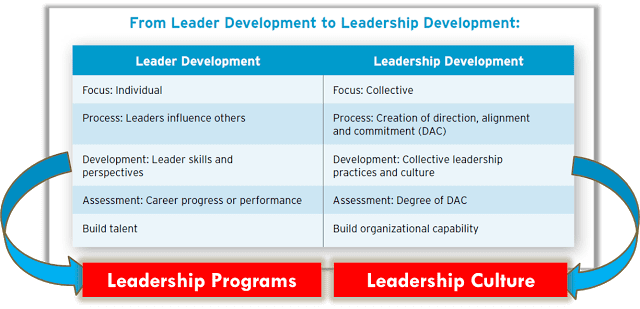When Ursula Alvarez, chief talent officer at Credicorp Group, was asked how she planned to approach learning and development to support a new business strategy for rapid expansion across the Americas she said, “In our formula for success performance equals people. We know the talent drivers and individual competencies to focus on in order to develop strong individual leaders. The task now becomes building the collective leadership capability to meet radically new strategic challenges across the organization as we transform our business model.”
Inherent in Alvarez’s statement is the crux of an approach to learning and development that is critical for leaders who are engaged in business model transformation — the need to invest in both leader development to enable people to perform to their highest potential and leadership development to build collective leadership capability and culture to perform in line with strategic objectives.

This dual approach is critical to build the depth and breadth of strategic leadership that drives superior organizational performance over time.
At the individual level this approach evokes questions such as: What individual competencies do leaders need to develop to meet their strategic challenges, influence others in a strategic way, achieve individual performance expectations, develop their direct reports and manage their teams?
At the same time learning leaders need to consider the strategic challenges the organization faces while bolstering its competitive positioning. What organizational capabilities need to be developed to create direction, alignment and commitment across the organization, shape the leadership culture, span organizational boundaries, leverage paradoxical priorities and lead transformational change?
As Alvarez said, most organizational learning leaders these days are well-versed in supporting development for individuals in their organizations and tend to have a well-defined set of competencies they build training activities around. What may be missing is a developmental approach to build the collective leadership capability required to enact strategic change. What do leaders need to be able to do exceptionally well as a cohesive and collaborative collective to drive transformational change and unleash the organization’s performance potential?
To execute strategic change, learning leaders should ask 12 questions to assess strategic leadership capability around the following strategic leadership practices:
Assess the internal and external environments. To what extent do we as organizational leaders regularly and realistically evaluate our internal strengths and weaknesses and the external opportunities and threats?
Clarify mission, vision and values. To what extent do we establish an organizational lens that creates a shared vision of the future and understanding of our operating principles?
Discover and prioritize drivers. To what extent do we prioritize the key strategic drivers to create focus on mission-critical activities?
Create business strategies. To what extent do we craft business strategies that will take us from where we are today to our desired future state?
Develop leadership strategies. To what extent do we craft leadership strategies that act as enablers of our business strategies?
Execute, perform and learn. To what extent do we effectively translate strategy into practice, learn from our performance outcomes and revisit our strategic framework?
Lead change. To what extent do we foresee the changes to the business environment that will bring increased complexity and new tensions to the organization as leaders engage in transformative business model change?
Shape culture. To what extent do we shape organizational cultures that elicit strong identification and a sense of belonging in individuals?
Span boundaries. To what extent do we implement tactics to span organizational boundaries to facilitate interdependent decision-making and collaboration between organizational leaders?
Leverage polarities. To what extent do we reap the upside of organizational priorities that may appear to be diametrically opposed?
Create direction, alignment and commitment. To what extent do we create direction, alignment and commitment with strategic objectives throughout the organization?
Unleash performance potential. To what extent do we think, act and influence strategically to reap the full performance potential of the organization?
Once leaders have engaged in open, honest, challenging dialogue to assess their ability to convert strategic intent into organizational practice, learning leaders can begin to craft a leadership architecture which unites the development of individual leader competency with organizational capability to lead strategic change.
David Dinwoodie is a senior faculty member and regional director for Latam Leadership Solutions at the Center for Creative Leadership and co-author of “Becoming a Strategic Leader: Your Role in Your Organization’s Enduring Success.” He can be contacted at editor@CLOmedia.com.














